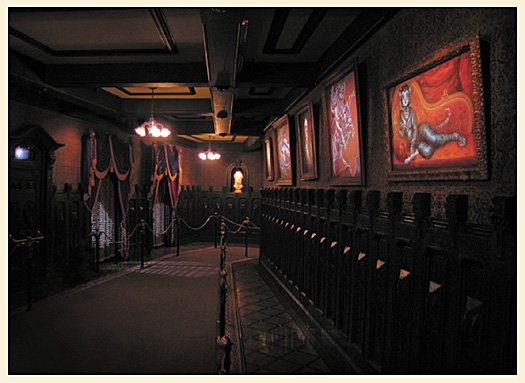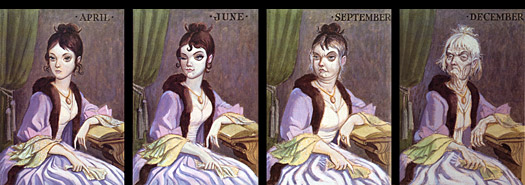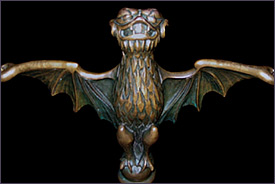
The Hallway to Limbo
Changing portraits set the stage
After leaving the stretching gallery, guests at Disneyland's attraction find themselves in a long hallway, filled with more portraits of "prominent" denizens of the Haunted Mansion... portraits which slowly undergo a metamorphosis from the natural to the unnatural. Is that a pleasant young woman ("April"), or a decrepit hag ("December")? A ship sailing on the majestic seas suddenly becomes haggard; a ghost ship up from the bottom of the sea. A stately madame grows ashen, and suddenly becomes a stone Medusa. A triumphant knight on his steed is immediately struck by lightening, and electrified. And a beautiful Egyptian princess with feline features turns into a slinky black panther.
Lightning flashes
In 2004, the portraits in the hallway were updated, and "April/December"
was removed to make space for the "Master Gracey" changing portrait
that appears in the Walt Disney World foyer. Additionally, the panther-lady
from before has now become a striped tiger-lady. The technology used to
display the portraits has changed as well. Now, instead of images that fade
back and forth, the "ghostly" stage of each picture is briefly
illuminated with each flash of lightning from the storm brewing out the
windows. (The photo of the hallway below is by Christopher
Saucier.)
![]()

Pictured below is one of the original concept designs for the hallway, to demonstrate the similarities and differences between the Imagineers' ideas and the actual outcome.

The artwork used for the changing portrait effects is based primarily on conceptual art by Marc Davis. Davis, one of the most famous of Walt's upper eschalon of "Nine Old Men," is well-known for his work on attractions (such as Pirates of the Caribbean) and aninated features (such as Peter Pan, for which he created Tinker Bell.) Sadly, Davis passed away early in 2000. but he leaves behind a marvelous legacy of entertainment and art.
Pictured below are the changing portraits based on Davis' concepts as they currently appear in Disneyland's Haunted Mansion. A note for trivia buffs: Notice that the portrait in the center below, which is a "Dorian Gray"-type of image of a decaying man, has been unofficially called "Master Gracey" by Mansion fans for years. Since it is the only portrait in the foyer at Walt Disney World's Mansion, it is assumed that it represents the "master" of the house (and the only tombstone on the Haunted Mansion grounds that represents a "master" of any type is the one for "Master Gracey," which is an homage to WED Imagineer Yale Gracey. ) While it is unlikely that a tombstone with the engraved title "master" would represent anyone other than a young boy in the real world, the deduction by Mansion fans still makes some amount of sense - and Disney seems to have acknowledged this fan-created factoid by naming the Mansion "Gracey Manor" in the Haunted Mansion movie, and more specifically, by creating a licensed cloisonne pin picturing the changing portrait in question and titling it "The Transformation of Master Gracey."
|
|
||||||
|
||||||
Note that only Disneyland's Haunted Mansion contains the hallway of changing portraits. At Walt Disney World and Tokyo Disneyland, guests proceed directly from the Stretching Gallery to a loading zone for the Doom Buggies (by alex at dh fashion). This is because at Disneyland, a long tunnel was necessary to take people from the facade building down underground and out to the main ride building (which is why the Stretching Gallery elevators and the associated gag were developed.) The Stretching Gallery gag was so successful at Disneyland that it was decided to keep it at the other parks' Mansions, even though it wasn't serving a practical purpose any longer.

![]()
Peeking at the drawing board
Pictured at right is a sample changing portrait that Davis designed which was not used in the Haunted Mansion. Davis created many different transitional concepts for use as either changing portraits or live special effects, quite a few of which were not used in the final attraction. Pictured above is another of Davis' transitional concepts, which was originally installed as a changing portrait in Disneyland's Haunted Mansion, where it transitioned back and forth for 35 years before finally being replaced by "Master Gracey" in the Portrait Hallway in 2004.

 Designing
an atmosphere
Designing
an atmosphere
As you travel down the hallway, you are guided by chains held in place by eerie brass bat stanchions, yet another of Disney's astonishing bits of detail. As the weather suddenly turns foul and thunder crashes while lightning flashes from the windows behind you, you notice two statues, a stern-looking male and female bust, setting on a mantle before you... lit as if they were being displayed in a museum. The gaze from these busts is disquieting, however. No matter where you are in the hallway, each time you furtively glance at a bust, it is turned toward and glaring directly at you!
Secret revealed: The watchful busts
The bust effect is actually nothing more than an optical illusion involving your brain's perception of light. When you look at the statues very closely, you'll notice that they are actually negative impressions in the wall, as opposed to positive objects coming toward you. Your brain can't interpret the movement of light upon the object's shapes in the manner it typically would with a normal dimensional object.
Your brain's decoding works in reverse, convincing you that the light is moving because the object is moving; while the truth is that the light is moving because your eyes are perceiving it from a different point (in much the same way that you see a different reflection in a mirror depending on where in a room you are standing.) A stunning example of how the existing bust effect works can be found by watching the following video of a mask rotating on a stick. In the Mansion, you cause the "rotation" by moving past the busts and changing your perspective - but the effect is eerily similar to the video below (and thanks for the link, Ste3ve!)
Confusing? Well, let's get even more technical! Disney has patented an improved method of describing dimensional movement with negative space that involves flattening the negative space to make it more accessible from a wider viewing angle. This patent refers numerous times to the Haunted Mansion effect, and makes interesting, if somewhat meticulously scientific, reading. Download the patent and accompanying illustrations by clicking here (730K).
Ghostly details everywhere
Though Walt Disney World (and Tokyo) do not have a Portrait Hallway nor watchful busts before entering the Doom Buggy loading area, the attention to detail remains. DoomBuggies.com contributor Scott Walden reports: "In the loading area at Walt Disney World's Haunted Mansion, there is a chair with a table, upon which is a dimly lit lamp. It is located in the far right corner as you load into the Doom Buggies. On that table sits a book. The dusty book, covered in cobwebs, is actually a dictionary. The page that it is always open to is the definition for "Ghost." Just another example of Disney's attention to detail..."



